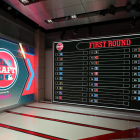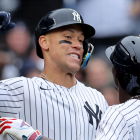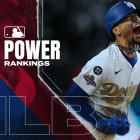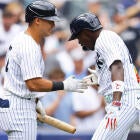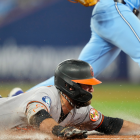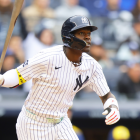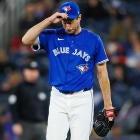The five-round 2020 MLB Draft is in the books. A total of 160 selections were made over two nights in the abbreviated selection process. MLB shortened the 2020 draft from 40 rounds to five rounds this year in a cost-cutting move amid the coronavirus pandemic.
The Detroit Tigers picked Arizona State infielder Spencer Torkelson with the No. 1 overall pick, which was expected. But there were plenty of surprises in the early going.
You can find the full list of every selection below, and we here at CBS Sports provided analysis of each of the 29 first-round picks that were made Wednesday night. Team-by-team draft grades can be found here.
Here's the full 2020 MLB Draft tracker:
| 1 | |
Spencer Torkelson, 1B/3B, Arizona State You'd think Torkelson was a Joe Hill creation given the fear he invokes in opposing pitchers. He walked in 31 of his 82 plate appearances during the abbreviated NCAA season, but he still managed to improve his career homer count to 54 in 498 at-bats. Torkelson has the requisite eye, strength, and barrel control to profile as a quick-moving thumper. The biggest knock on him is that he's only a right-handed first baseman, and those seldom make for satisfying early selections -- it's basically a sample of the ballad of Andrew Vaughn, the third pick in last year's draft. Don't be surprised when Torkelson ends up going higher than Vaughn, perhaps even first. | |
| 2 | |
Heston Kjerstad, OF, Arkansas Heston won't be the first Kjerstad to play pro ball: his brother Dexter spent a number of seasons as part of the Kansas City Royals and Miami Marlins organizations. He does have a chance to become the first one in his family to reach the majors, however. Kjerstad is a big left-hander with ample strength and a bad-ball appetite that keeps his walk rate lean. He has a track record of hitting against good pitching (.343/.421/.590 in three years of playing SEC competition), and this season he sliced into his strikeout rate, reducing it from 19.6 percent to 11.5 percent. Teams will have to decide if they trust his odd, albeit adaptable swing enough to project him as a Corey Dickerson type. If so, Kjerstad could be the first collegiate outfielder off the board. | |
| 3 | |
Max Meyer, RHP, Minnesota Call Meyer the Murder Hornet because he's small but fierce. He's about Sonny Gray-sized, yet he has well-above-average arm strength that lets him touch the upper-90s, and a wipeout slider that is one of the best secondary pitches in the draft. If asked, he could probably pitch out of a big-league bullpen this season. Obviously the long-term hope for Meyer is that he's a frontline starter. He can't do anything about his height, so he'll need to improve his changeup and perhaps tweak his delivery so he doesn't land quite as open. Given his athleticism and pair of top-end pitches, he has a better chance than most at defying the stigma against short righties. | |
| 4 | |
Asa Lacy, LHP, Texas A&M Over the last three seasons, six left-handed starters have averaged 150 innings and more than a strikeout per inning: Chris Sale, Robbie Ray, Patrick Corbin, Eduardo Rodriguez, Clayton Kershaw, and Matthew Boyd. Lacy, who struck out 46 batters in 24 innings this season, seems primed to join that group in the coming years. At minimum, he has the highest upside and the best shot at realizing it among the pitchers in the class. Lacy's repertoire features four usable or better pitches, including a low-to-mid-90s fastball and a slider that each grade as elite offerings, according to Trackman data. He also has the frame and demeanor scouts seek in their top-of-the-rotation prospects. The major (and arguably only) flaw in his game is his command: even though he walked three batters per nine in this abbreviated season, he still finished his Aggies career having walked four per nine. If Lacy can improve in that regard, he has the weaponry to become a frontline starter. Otherwise, he'll likely settle in as a mid-rotation starter who has stretches and seasons where he teases more (think the aforementioned Ray). | |
| 5 | |
Austin Martin, CF/INF, Vanderbilt Martin, a top-of-the-order hitter and versatile defender, might be the most intriguing player in the class. He has an impressive feel for contact and for the strike zone, finishing his Commodores career with a .368 batting average and more walks than strikeouts. (He was the toughest batter to strike out in the power conferences.) Though he homered just 14 times, his exit velocities suggest there's plus power potential under the surface, something he could achieve thanks to his offensive aptitude and a swing that already features loft. In short, Martin fits the profile of others who have added power to their games in recent years. He's also a skilled baserunner with good speed and smarts. Generally, having an undefined position is a negative. In Martin's case, it could turn out to be a positive. He was primarily a third baseman before this season, when he slid to center field to better leverage his wheels. A creative team could maximize his value by having him split time between the infield and the outfield, a la Whit Merrifield and Scott Kingery, among others. | |
| 6 | |
Emerson Hancock, RHP, Georgia Hancock does not have Lacy's top-end potential because he does not have Lacy's two top-end pitches. He might have the higher floor, however, thanks to a well-rounded arsenal and a better feel for throwing strikes. Hancock has three pitches that could be classified as above-average: his low-to-mid-90s fastball, his changeup, and his slider. His delivery features some recoil, yet he walked just over seven percent of the batters he faced in three years against top-end SEC competition. (Lacy, in the same conference, walked nearly 11 percent.) Of course, Hancock should be allowed to exist outside of the comparisons to Lacy. He's a high-quality pitcher who ought to hold down a big-league rotation spot for years to come, beginning sooner than later.Hancock does not have Lacy's top-end potential because he does not have Lacy's two top-end pitches. He might have the higher floor, however, thanks to a well-rounded arsenal and a better feel for throwing strikes. Hancock has three pitches that could be classified as above-average: his low-to-mid-90s fastball, his changeup, and his slider. His delivery features some recoil, yet he walked just over seven percent of the batters he faced in three years against top-end SEC competition. (Lacy, in the same conference, walked nearly 11 percent.) Of course, Hancock should be allowed to exist outside of the comparisons to Lacy. He's a high-quality pitcher who ought to hold down a big-league rotation spot for years to come, beginning sooner than later. | |
| 7 | |
Nick Gonzales, 2B, New Mexico State If one of the top-ranked hitters is going to slide on draft day, then it's probably going to be Gonzales. Despite incinerating the Western Athletic Conference (.448/.610/1.155 slash line with 12 home runs and 11 more walks than strikeouts in 16 games) and last summer's Cape Cod League (.351/.451/.630), there are nagging concerns about his upside. His exit velocities were more pedestrian than one might suspect, leading some evaluators to believe his power potential (and the validity of comparisons to Milwaukee Brewers second baseman Keston Hiura) is overstated. A data-driven team might find it hard to justify popping Gonzales so early, lest they end up with a singles-hitting second baseman who isn't a threat to run or win a Gold Glove. | |
| 8 | |
Robert Hassell, OF, Independence (HS) Hassell, another well-regarded Vanderbilt commitment, is a legit prospect as a pitcher and outfielder. Evaluators favor him at the plate, where he employs an aesthetically pleasing left-handed swing that some believe will eventually produce above-average power. He has some backers in the industry who think he could become the best hitter in the class. | |
| 9 | |
Zac Veen, OF, Spruce Creek (HS) With due respect to the fine people at the University of Florida, there's little chance Veen will be crossing paths with the Tom Petty tree anytime soon. Instead, he's likely to be popped early enough to justify beginning his pro career. Veen has the tall, lean, broad-shouldered frame that bodes well for him adding muscle over the coming years (and for drawing comparisons to Jayson Werth). He also has more than enough bat speed and discretion at the plate to project as a potential middle-of-the-order hitter. Veen's odds of remaining in the middle of the outfield are considerably more remote, but his strong arm should make him a fit in right field. | |
| 10 | |
Reid Detmers, LHP, Louisville Louisville has produced a pair of top-five picks in recent years, in outfielder Corey Ray (No. 5, 2016) and two-way-player Brendan McKay (No. 4, 2017). Those two are the only Cardinals ever taken in the top 20, let alone the top 10. Detmers will change that this summer. He finished his career at Louisville with a four-start stretch that saw him post a 1.23 ERA and strike out 19.6 batters per nine innings. You read that right: he fanned more than two per inning, or 48 of the 91 batters he faced, and he did that while allowing 16 hits, three runs, and six walks. Detmers, whose delivery and high three-quarters release will remind some of Drew Smyly or Tarik Skubal, pairs a low-90s fastball with a slow, knee-buckling curveball. Scouts have concerns that the curve won't be as effective against big-league hitters due to its low-to-mid-70s velocity and its out-of-hand visibility. Detmers could help his own case by nursing along his slider and changeup. Should he prove successful, he ought to be a quick-to-rise mid-rotation starter. | |
| 11 | |
Garrett Crochet, LHP, Tennessee Crochet missed the onset of the season due to injury, meaning his first start of the year doubled as his last. The availability heuristic might work against him on draft day: teams will ostensibly view him as a starter, but he opened in just 13 of his 36 appearances over three years with the Volunteers. To Crochet's credit, he does have the essential attributes teams desire in their starters: a big frame (6-foot-6), a strong arm (he can flirt with triple digits), and an out pitch (his slider). Should he fail in the rotation, he'd probably make a mighty fine setup man. | |
| 12 | |
Austin Hendrick, OF, West Allegheny (HS) The most notable baseball alum from West Allegheny High School is Scott Patterson, who played Luke on Gilmore Girls. Hendrick could usurp Patterson if he someday lands the role of cleanup hitter. His explosive swing lends itself to an approach that sees him trade contact for power. Hendrick scorched good competition last summer, posting absurd exit velocities along the way, and that performance ought to protect him against the typical cold-weather state bias. Not every team has the stomach for his swing-and-miss tendencies, and it's easy to envision him becoming a left-handed Clint Frazier, but that isn't the worst outcome by any means. | |
| 13 | |
Patrick Bailey, C, NC State A collegiate catcher has been selected either first (Adley Rutschman in 2019) or second overall (Joey Bart, 2018) in the last two drafts. That didn't happen this year, but Bailey came off the board early thanks to his high floor and the evergreen demand for catchers. He's more than adequate at the defensive tasks that matter most -- receiving and throwing -- and he has ample game-calling experience. Scouts are less bullish on his bat. While he's skilled at working deep counts and punishing mistakes with his above-average raw power, he's a candidate to finish with a below-average hit tool due in part to his tendency to whiff. (He struck out in nearly a quarter of his plate appearances this season in 17 games.) Bailey's boosters believe he'll have four average or better tools, and that'll be enough for him to go in the top half of round one, even if others think he'll fall on the spectrum between second-division starter and backup. | |
| 14 | |
Justin Foscue, 2B/3B, Mississippi State Foscue isn't going to win many footraces. He can handle himself at the plate, though, and proved as much by hitting .297/.380/.482 with 19 home runs and 10 more walks than strikeouts. (He struck out three times in 69 plate appearances this season.) Foscue will have to work on his defense, but his track record of making contact, commanding the zone, and posting above-average exit velocities should attract a team with a good development staff. | |
| 15 | |
Mick Abel, RHP, Jesuit (HS) Abel went 15th despite the pandemic wiping out his season, and preventing teams from taking additional looks. Based on their past observations, Abel has a chance to be a high-quality big-league starter. He has a tall, lean frame that ought to support muscle gain over the coming years; he's a good athlete who can repeat his delivery, boding well for his command and control; and his arsenal includes three flowering pitches: a lively fastball that can bump the upper-90s and a slider and a changeup. The top of this class is loaded with good college arms, so Abel might slip outside of the top five. Whatever team gets him should be thrilled. | |
| 16 | |
Ed Howard, SS, Mount Carmel (HS) Howard isn't just the best bet among prep players in this class to remain at shortstop, he's arguably the purest shortstop to come along in years. He has all the attributes that scouts look for defensively: a strong arm, soft hands, nimble footwork, and an innate feel for the position. Howard's offensive value is tougher to peg. The hope is that he can add power as he fills out his lanky 6-foot-2 frame, but there's a chance his bat plays light. (It doesn't help his stock that he's from Illinois, a cold-weather state, either.) Nonetheless, the wide berth granted by his secondary skills should permit Howard to go early in the draft to a team looking for a potential starting shortstop. | |
| 17 | |
Nick Yorke, SS, Archbishop Mitty HS Nick Yorke is a small, hit-over-power middle infielder with a commitment to Arizona. It's to be determined if he can stick at shortstop. Yorke doesn't appear to have the power required to stand out at either second or third base, so his defensive home could determine if he's more than a bench type. | |
| 18 | |
Bryce Jarvis, RHP, Duke Jarvis received a lot of attention in February, when he threw a perfect game against Cornell. He followed up that start with a pair of dominating performances against Purdue and Florida State that brought his seasonal totals to 27 innings, 11 hits, two walks, two earned runs, and 40 strikeouts. Jarvis has improved his velocity, now pitching in the mid-90s, and he has one of the draft's best changeups. His slider is also a quality offering, giving him three legit weapons. His uptempo delivery is a little awkward, and he has a history of walking more than four batters per nine. Teams will likely give him the benefit of the doubt in that regard, given his hard work and marked improvement in other areas, with someone eyeing him as a mid-rotation starter. | |
| 19 | |
Pete Crow-Armstrong, OF, Harvard-Westlake (HS) If Harvard-Westlake's name sounds familiar, that's because it's the same school that has produced Jack Flaherty, Lucas Giolito, and Max Fried. If Crow-Armstrong's name sounds familiar, that's because his parents are both actors (Ashley Crow and Matthew Armstrong) and he's the same outfielder who made a terrific grab during the Under-18 Baseball World Cup. He could be an impact-level defender in center thanks to his range, arm, and all-out demeanor. He isn't expected to be a zero at the plate, either, thanks to a contact-tailored swing that could make him a leadoff type. Crow-Armstrong may be a Vanderbilt commit, but he seems unlikely to ever caw on campus. | |
| 20 | |
Garrett Mitchell, OF, UCLA Mitchell is one of the fastest runners in the class, and he should have no problem remaining in center for the long haul. (He played right in 2019 out of deference to former first-round pick Matt McLain, who moved to shortstop this season.) The other elements of his game are less certain. Mitchell has the kind of athleticism and angular frame that scouts dream about, and he puts on a better BP than his in-game power numbers indicate (his .151 career ISO is propped up by 15 triples, as compared to six home runs). He's already reconfigured his swing once since high school, and a team hoping to help him unlock his star potential could task him with trying it again. Mitchell, a Type 1 diabetic, should serve as a positive role model regardless. | |
| 21 | |
Jordan Walker, 3B, Decatur (HS) Walker, armed with a Duke commitment, is viewed as a tougher sign than his peers. If he signals to teams he's turning pro, he should be the top prep corner infielder off the board. Walker is listed at 6-foot-5, which would tie him with Kris Bryant for the tallest third baseman in the majors. Predictably, one of his top selling points is his power potential. Even more predictably, there are concerns he'll have to move away from the hot corner due to his size. A team who believes he can play third and hit in the middle of the order could pop him in the first round. | |
| 22 | |
Cade Cavalli, RHP, Oklahoma Cavalli is a former two-way player who looks good in the uniform and who hit .319/.393/.611 in 2019. Focusing exclusively on pitching this year paid off, as he showed improved control by walking five batters in 23 innings; he'd previously walked five per nine in 90-plus innings between Oklahoma and the Cape Cod League. Cavalli has a fastball he can run into the mid-to-upper-90s as well as a quality slider. | |
| 23 | |
Carson Tucker, SS, Mountain Pointe (HS) Carson Tucker is the younger brother of Cole, an infielder with the Pittsburgh Pirates. This Tucker has a broad base of skills, and he has enough arm strength and speed to stick at short. He's committed to Texas, but figures to be signable. | |
| 24 | |
Nick Bitsko, RHP, Central Bucks East (HS) No pitcher ranked this highly on this list has less on file than Bitsko does. He reclassified earlier in the year from the 2021 draft, putting the onus on his performance this spring. That decision could have played in his favor under normal circumstances, but the spread of the novel coronavirus caused his season to be canceled. He's still a candidate to go high in the draft because of what teams saw in the past: a good, physical frame; a clean delivery; a hot fastball; and a curveball that looks good through the lens of Trackman. Bitsko has to be convinced to forego his commitment to the University of Virginia, meaning whatever team takes him will have to put its money where its confidence is. It could pay off, and some, if that team is right. | |
| 25 | |
Jared Shuster, LHP, Wake Forest Few, if any pitchers in this class have improved their stock as much as Shuster has over the past year. Despite walking nearly five batters per nine in 2019, he's walked just nine batters over his last 11 appearances, dating back to the Cape Cod League. His precision gains have coincided with a velocity boost that enables him to touch into the mid-to-upper-90s. | |
| 26 | 
Athletics
|
Tyler Soderstrom, C, Turlock (HS) There's disagreement on whether Soderstrom should remain behind the plate. He has a strong arm, but he's a work-in-progress in other ways. Besides, his offensive upside is such that moving him to another position could free up his bat and hasten his arrival. | |
| 27 | |
Aaron Sabato, 1B, North Carolina As with Torkelson, it's hard to justify taking a right-handed first baseman early on. Sabato, a draft-eligible sophomore, had an impressive college career that saw him hit .332/.459/.698 with 25 home runs in 83 games. Sabato's game may not feature another average or better tool outside of his bat, so he'll have to hit, hit, and then hit some more in order to justify his selection and punch his ticket to the Show. | |
| 28 | |
Austin Wells, C, Arizona Wells' standing is tied to a team's belief that he can catch. As it is, his bat is doing the heavy lifting. A draft-eligible sophomore, he hit .357/.476/.560 with seven home runs and more walks than strikeouts in 71 games with the Wildcats. (He also had a strong showing in the Cape Cod League, batting .308/.389/.526, albeit with a higher K rate.) Wells has a pretty swing from the left side, and he has a chance to further tap into his power. The risk is, as suggested, with his defense. He has a substandard arm, and he doesn't grade as a good receiver. He could end up at the other end of the defensive spectrum, either at first base or in the outfield; alternatively, he could benefit more than any other draftee from robot umpires. | |
| 29 | |
Bobby Miller, RHP, Louisville Miller has a big, strong frame. He has a firm fastball with plenty of oomph. He has a pair of average or better secondaries. And so on. What's not to like? Mostly his delivery, which includes a long, whip-like arm action that robs him of command and could threaten his long-term well being. Some team that believes in his ability to stick in a rotation could take him earlier. | |
Competitive Balance Round A
30. Orioles: Jordan Westburg, SS, Mississippi State
31. Pirates: Carmen Mlodzinski, P, South Carolina
32. Royals: Nick Loftin, SS, Baylor
33. Diamondbacks: Slade Cecconi, P, Miami
34. Padres: Justin Lange, P, Llano (HS)
35. Rockies: Drew Romo, C, Woodlands (HS)
36. Indians: Tanner Burns, P, Auburn
37. Rays: Alika Williams, SS, Arizona State
Round 2
38. Tigers: Dillon Dingler, C, Ohio State
39. Orioles: Hudson Haskin, OF, Tulane
40. Marlins: Dax Fulton, P, Mustang (HS)
41. Royals: Ben Hernandez, P, De La Salle (HS)
42. Blue Jays: CJ Van Eyk, P, Florida State
43. Marines: Zach DeLoach, OF, Texas A&M
44. Pirates: Jared Jones, P, La Mirada (HS)
45. Padres: Owen Caissie, OF, Notre Dame Catholic (HS)
46. Rockies: Chris McMahon, P, Miami
47. White Sox: Jared Kelley, P, Refugio (HS)
48. Reds: Christian Roa, P, Texas A&M
49. Giants: Casey Schmitt, 3B, San Diego State
50. Rangers: Evan Carter, OF, Elizabethton (HS)
51. Cubs: Burl Carraway, P, Dallas Baptist
52. Mets: J.T. Ginn, P, Mississippi State
53. Brewers: Freddy Zamora, SS, Miami
54. Cardinals: Masyn Winn, SS, Kingwood (HS)
55. Nationals: Cole Henry, P, LSU
56. Indians: Logan Allen, P, Florida International
57. Rays: Ian Seymour, P, Virginia Tech
58. Athletics: Jeff Criswell, P, Michigan
59. Twins: Alerick Soularie, OF, Tennessee
60. Dodgers: Landon Knack, P, East Tennessee State
Competitive Balance Round B
61. Marlins: Kyle Nicolas, P, Ball State
62. Tigers: Daniel Cabrera, OF, LSU
63. Cardinals: Markevian Hence, P, Watson Chapel (HS)
64. Mariners: Connor Phillips, P, McLennan CC
65. Reds: Jackson Miller, C, J.W. Mitchell (HS)
66. Dodgers: Clayton Beeter, P, Texas Tech
Compensation Round
67. Giants: Nick Swiney, P, NC State
68. Giants: Jimmy Glowenke, SS, Dallas Baptist
69. Mets: Isaiah Greene, OF, Corona (HS)
70. Cardinals: Alec Burleson, 1B, East Carolina
71. Nationals: Samuel Infante, SS, Monsignor Pace (HS)
72. Astros: Alex Santos, P, Mount Saint Academy (HS)
Round 3
73. Tigers: Trei Cruz, SS, Rice
74. Orioles: Anthony Servideo, SS, Mississippi
75. Marlins: Zach McCambley, P, Coastal Carolina
76. Royals: Tyler Gentry, OF, Alabama
77. Blue Jays: Trent Palmer, P, Jacksonville
78. Mariners: Kaden Polcovich, 2B, Oklahoma State
79. Pirates: Nick Garcia, P, Chapman
80. Padres: Cole Wilcox, P, Georgia
81. Rockies: Sam Weatherly, P, Clemson
82. Angels: David Calabrese, OF, St. Elizabeth Catholic
83. White Sox: Adisyn Coffey, P, Wabash Valley College
84. Reds: Bryce Bonnin, P, Texas Tech
85. Giants: Kyle Harrison, P, De La Salle (HS)
86. Rangers: Tekoah Roby, P, Pine Forest (HS)
87. Phillies: Casey Martin, SS, Arkansas
88. Cubs: Jordan Nwogu, OF, Michigan
89. Red Sox: Blaze Jordan, 3B, DeSoto Central (HS)
90. Diamondbacks: Liam Norris, P, Green Hope (HS)
91. Mets: Anthony Walters, SS, San Diego State
92. Brewers: Zavier Warren, C, Central Michigan
93. Cardinals: Levi Prater, P, Oklahoma
94. Nationals: Holden Powell, P, UCLA
95. Indians: Petey Halpin, OF, Mira Costa (HS)
96. Rays: Hunter Barnhart, P, St. Joseph (HS)
97. Braves: Jesse Franklin, OF, Michigan
98. Athletics: Michael Guldberg, OF, Georgia Tech
99. Yankees: Trevor Hauver, 2B, Arizona State
100. Dodgers: Jake Vogel, OF, Huntington Beach (HS)
101. Astros: Ty Brown, P, Vanderbilt
Round 4
102. Tigers: Gage Workman, 3B, Arizona State
103. Orioles: Coby Mayo, 3B, Stoneman Douglas (HS)
104. Marlins: Jake Eder, P, Vanderbilt
105. Royals: Christian Chamberlain, P, Oregon State
106. Blue Jays: Nick Frasso, P, Loyola Marymount
107. Mariners: Tyler Keenan, 3B, Mississippi
108. Pirates: Jack Hartman, P, Appalachian State
109. Padres: Levi Thomas, P, Troy
110. Rockies: Case Williams, P, Douglas County (HS)
111. Angels: Werner Blakely, SS, Detroit Edison (HS)
112. White Sox: Kade Mechals, P, Grand Canyon
113. Reds: Mac Wainwright, OF, St. Edward (HS)
114. Giants: R.J. Dabovich, P, Arizona State
115. Rangers: Dylan Maclean, P, Central Catholic (HS)
116. Phillies: Carson Ragsdale, P, South Florida
117. Cubs: Luke Little, P, San Jacinto College
118. Red Sox: Jeremy Wu-Yelland, P, Hawaii
119. Diamondbacks: A.J. Vukovich, 3B, East Troy (HS)
120. Mets: Matthew Dyer, C, Arizona
121. Brewers: Joey Wiemer, OF, Cincinnati
122. Cardinals: Ian Bedell, P, Missouri
123. Nationals: Brady Lindsly, C, Oklahoma
124. Indians: Milan Tolentino, SS, Santa Margarita (HS)
125. Rays: Tanner Murray, SS, UC Davis
126. Braves: Spencer Strider, P, Clemson
127. Athletics: Dane Acker, P, Oklahoma
128. Twins: Marco Raya, P, United South (HS)
129. Yankees: Beck Way, P, Northwest Florida State
130. Dodgers: Carson Taylor, C, Virginia Tech
131. Astros: Zach Daniels, OF, Tennessee
Round 5
132. Tigers: Colt Keith, 3B, Biloxi (HS)
133. Orioles: Carter Baumler, P, Dowling Catholic
134. Marlins: Kyle Hurt, P, USC
135. Royals: Will Klein, P, Eastern Illinois
136. Blue Jays: Zach Britton, OF, Louisville
137. Mariners: Taylor Dollardm, P, Cal Poly
138. Pirates: Logan Hofmann, P, Northwestern State
139. Padres: Jagger Haynes, P, West Columbus (HS)
140. Rockies: Jack Blomgren, SS, Michigan
141. Angels: Adam Seminaris, P, Long Beach State
142. White Sox: Bailey Horn, P, Auburn
143. Reds: Joe Boyle, P, Notre Dame
144. Giants: Ryan Murphy, P, Le Moyne College
145. Rangers: Thomas Saggese, SS, Carlsbad (HS)
146. Phillies: Baron Radcliff, OF, Georgia Tech
147. Cubs: Koen Moreno, P, Panther Creek (HSS)
148. Red Sox: Shane Drohan, P, Florida State
149. Diamondbacks: Brandon Pfaadt, P, Bellarmine
150. Mets: Eric Orze, P, University of New Orleans
151. Brewers: Hayden Cantrelle, SS, Louisiana Lafayette
152. Cardinals: LJ Jones IV, OF, Long Beach State
153. Nationals: Mitchell Parker, P, San Jacinto College
154. Indians: Mason Hickman, P, Vanderbilt
155. Rays: Jeff Hakanson, P, Central Florida
156. Braves: Bryce Elder, P, Texas
157. Athletics: Stevie Emanuels, P, Washington
158. Twins: Kala'i Rosario, OF, Waiakea (HS)
159. Dodgers: Gavin Stone, P, Central Arkansas
160: Astros: Shay Whitcomb, 2B, UC San Diego
![[object Object] Logo](https://sportshub.cbsistatic.com/i/2020/04/22/e9ceb731-8b3f-4c60-98fe-090ab66a2997/screen-shot-2020-04-22-at-11-04-56-am.png)




































